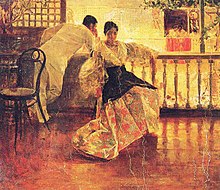

The María Clara gown, historically known as the traje de mestiza during the Spanish colonial era,[1][2] is a type of traditional dress worn by women in the Philippines. It is an aristocratic version of the baro't saya. It takes its name from María Clara, the mestiza protagonist of the novel Noli Me Tángere, penned in 1887 by Filipino nationalist José Rizal. It is traditionally made out of piña, the same material used for the barong tagalog.[3]
A unified gown version of the dress with butterfly sleeves popularized in the first half of the 20th century by Philippine National Artist Ramon Valera is known as the terno,[4] which also has a shorter casual and cocktail dress version known as the balintawak.[5] The masculine equivalent of baro't saya is the barong tagalog.[6]
These traditional women's dresses in the Philippines are collectively known as Filipiniana dress. Along with the barong tagalog, they are also collectively known as "Filipiniana attire".[7][8]
- ^ Custodio, Arlo (May 27, 2018). "Championing Maria Clara beyond the Walls of Intramuros". The Manila Times. Retrieved January 26, 2019.
- ^ "Traje de Mestiza". Philippine Folklife Museum Foundation. Retrieved January 26, 2019.
- ^ Moreno, Jose "Pitoy". – Maria Clara, Philippine Costume, koleksyon.com, archived from the original on July 13, 2011.
- ^ "FAST FACTS: Who invented the Philippine terno?". Rappler. January 27, 2017. Retrieved January 26, 2019.
- ^ Miranda, Pauline (November 15, 2018). "The terno is not our national dress—but it could be". NoliSoil. Retrieved February 19, 2020.
- ^ "A Guide to the Philippines' National Costume". Philippine Primer. May 13, 2013. Retrieved February 19, 2020.
- ^ "Modern Filipiniana: The 2019 ABS-CBN Ball Dress Code". Metro.style. Retrieved November 4, 2022.
- ^ Garcia, Lawrence. "Filipiniana Dresses And How They've Changed Throughout History". Sinta & Co. Filipino Wedding Accessories. Retrieved November 4, 2022.
© MMXXIII Rich X Search. We shall prevail. All rights reserved. Rich X Search
